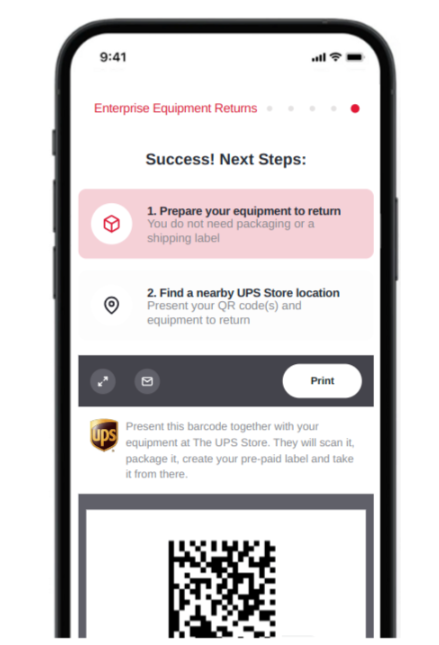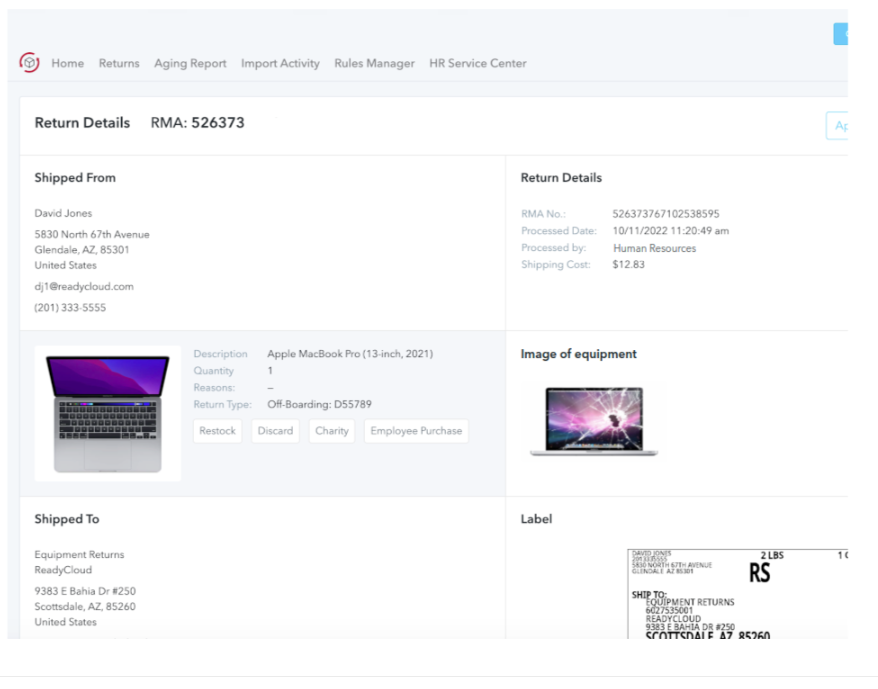Cracking the Code: How to Manage Equipment Returns from Remote Employees

Managing equipment returns from remote employees is essential for organizations navigating the complexities of a distributed workforce. With the surge in remote work, establishing a clear company policy on returning equipment, ranging from electronic devices to home office furniture, is crucial. This policy should be communicated effectively during onboarding to set clear expectations for both the company and its remote employees. Ensuring the return of company property in good working condition involves detailed guidelines, including deadlines, an itemized list of the equipment, packing instructions, and protocols for data backup and sanitizing.
At the heart of successful remote employee equipment returns lies efficient communication and logistics. Designating a team or point person to oversee the process ensures that all items are accounted for and in the right condition. Meanwhile, leveraging technology for equipment tracking and considering alternative solutions like allowing employees to purchase equipment can save costs and streamline processes. This article will guide organizations through developing and implementing an effective equipment return policy that addresses legal considerations, compliance, security concerns, and logistical challenges. ReadyCloud’s equipment return software provides a solution that simplifies the process, ensuring a smooth transition for both departing employees and the company.
Understanding the Importance of a Clear Policy
A clear and accessible equipment return policy plays a pivotal role in preventing disputes and additional charges related to returned equipment, ultimately contributing to positive experiences and satisfaction for both the company and its remote workers.
Organizations should meticulously consider the return window, set conditions for accepting used returned goods, establish restrictions on returnable items, and clearly explain how employees should initiate returns. Such clarity not only streamlines the process but also enhances trust and transparency between employers and remote employees.
In crafting an effective Remote Employee Equipment Agreement or Policy, several key components must be addressed:
- Return Window: Clearly define the period during which returns are accepted.
- Condition of Returns: Specify the condition in which items must be returned, such as unopened, with original tags, or not used outdoors.
- Initiating Returns: Outline the steps an employee needs to take to initiate a return, including whom to contact and what forms to complete.
- Responsibility for Return Shipping: For e-commerce or remote work scenarios, explicitly state who bears the cost of return shipping, which can significantly affect the willingness to comply with the policy.
Having a signed inventory of property and warning of potential civil or criminal penalties for non-compliance reinforces the seriousness of the policy. This approach not only protects the company’s assets but also ensures that employees are fully aware of their responsibilities and the consequences of non-compliance.
An effective employee equipment return policy serves as a guideline for both the company and its remote employees, ensuring that the process of returning company property is as smooth and dispute-free as possible. By establishing trust and setting clear expectations, companies can foster a positive work environment, even in a remote setting. This not only encourages employees to comply with the policy but also protects the company from improper returns and potential financial losses.
Developing an Effective Equipment Return Policy
Developing an effective equipment return policy begins with the foundational step of integrating clear guidelines into the employee handbook. Employers are encouraged to draft a comprehensive policy that covers the return of company property. This should include a detailed acknowledgment form that employees sign, affirming their understanding and agreement.
- Policy Content: The policy should clearly state that all equipment issued is the property of the company. It must include an authorization for the company to deduct the value of any unreturned equipment from the employee’s final paycheck. Should there be any remaining value that cannot be deducted, it should be outlined that this amount will either be paid by the employee or deducted from their severance.
- Damage Waiver and Security Deposit: Having a clear and explicit damage waiver that employees sign when receiving equipment can outline the types of damages they are responsible for. Additionally, consider implementing a security deposit to cover potential repair or replacement costs. This not only incentivizes employees to handle the equipment carefully but also provides a financial safeguard for the company.
- Technology Integration: Leverage technology solutions like ReadyReturns supports the entire lifecycle of the equipment, from issuance to retrieval, including maintenance needs and storage solutions. ReadyCloud’s comprehensive suite ensures a smooth onboarding and offboarding process, making equipment returns efficient and hassle-free.
In addition to these guidelines, it’s crucial to make the return process as straightforward as possible for employees. Employing a “What’s In It For Me” (WIIFM) mindset can motivate compliance. Clear, urgent, yet respectful communication is key to ensuring that employees understand the importance of returning company property promptly and in the right condition. By adopting these strategies, employers can create an effective equipment return policy that minimizes risk, ensures compliance, and maintains a positive relationship with remote employees.
Legal Considerations and Compliance
Navigating the legal landscape of equipment returns from remote employees requires a nuanced understanding of state laws and compliance requirements. Here’s what employers need to know:
State Laws on Paycheck Deductions: Laws vary significantly across states regarding the ability of an employer to deduct the cost of unreturned company property from an employee’s paycheck. For instance, some states allow deductions with the employee’s written consent, while others have stricter regulations. Employers must familiarize themselves with the specific laws of the states where their remote workers reside to ensure compliance. This includes understanding the permissible amount, timing, and method of deduction for unreturned equipment.
- In Michigan, for example, employers cannot make deductions from wages without the employee’s full, free, and written consent.
- It’s generally assumed that deductions should not reduce an employee’s final paycheck below the minimum wage for the hours worked in their final pay period.
Final Paycheck Regulations:
- A common misconception is that withholding an employee’s final paycheck until company property is returned is permissible.
- However, most state laws prohibit this practice, emphasizing the importance of employers understanding and adhering to jurisdiction-specific regulations.
- Employers should instead consider alternative recovery steps, such as sending a detailed letter or email to the employee requesting the return of items and providing a prepaid shipping label for convenience.
Legal Actions and Recovery Steps:
- If an employee refuses to return company laptops, computers or other property, employers have several avenues to pursue. Initial steps include sending a series of communications detailing the items that need to be returned. If these efforts are unsuccessful, more stringent measures may be necessary, including legal action. However, the decision to pursue legal recourse should be weighed carefully against the potential cost-effectiveness and impact on company morale among remaining employees. Legal advice is highly recommended before proceeding with these measures.
- Employers can also consider creating an official notice of termination that includes compensation, benefits, or rewards upon the return of equipment. This approach incentivizes compliance and may prevent the need for more drastic measures.
Employers should approach the equipment return and offboarding process with a clear understanding of the legal considerations involved. By doing so, they can protect their assets while maintaining a positive and compliant relationship with their remote workforce.
Communication Strategies for Equipment Return
Employers must recognize the significance of engaging with their remote employees in a manner that maintains morale while ensuring the return of company equipment. The approach taken can significantly impact the employer brand, especially in how ex-employees perceive their treatment regarding equipment returns.
- Prompt and Clear Communication: It’s essential to send reminders to employees about returning equipment as soon as they terminate employment or return to the office. These reminders should be concise, clear, and include all necessary details such as the company’s policy on equipment returns, a list of items to be returned, and the signed acknowledgment by the employee. This ensures there is no confusion regarding what is expected from the employee.
- Handling Equipment Damage: In cases where equipment is returned with damages, it’s critical to inspect the items within 24 hours and communicate any issues to the employee promptly. The communication should be in writing, detailing the damage, the associated costs, and include a signed copy of the binding contract and relevant photographs. This approach helps in maintaining transparency and ensures that the employee is fully aware of any issues with the returned equipment.
- Follow-Up Procedures: If an employee does not respond to the initial request to return equipment, employers should follow a structured approach to escalate the issue:
- First Follow-Up: Send a detailed letter or email listing the items to be returned and include a prepaid shipping label along with instructions for scheduling a pickup.
- Second Follow-Up: If there’s no response, send another communication emphasizing the importance of returning the company property and outline the consequences of failing to do so.
- Final Notice: After 30 days without a response, inform the employee through a letter or email that the company will exercise its legal rights, which could include filing a criminal charge of theft or a civil action to recover the value of the items.
By adopting a structured, respectful, and transparent communication strategy, employers can facilitate the smooth return of company equipment while preserving a positive relationship with their remote workforce. This approach not only protects the company’s assets but also upholds its reputation as a fair and considerate employer.
Logistics of Remote Equipment Collection
Managing the logistics of remote equipment collection presents unique challenges and requires a comprehensive strategy to ensure efficiency and compliance.
- Packaging and Labeling: Proper packaging is paramount to prevent damage during the return shipment. Employers should provide clear instructions on how to pack the equipment securely, including the use of bubble wrap or foam for sensitive devices. Correct labeling is equally crucial. A call tag or pick-up label should be provided to ensure the freight company collects the right equipment. This minimizes the risk of items getting lost or misplaced during transit.
- Inspection and Custom Items: Upon receipt of the returned equipment, a thorough inspection is necessary. This step determines if the equipment has been damaged or if it doesn’t match the reason for the return as initially stated. The outcome of this inspection can affect the refund or replacement process. It’s important to note that custom items, due to their specific nature, cannot be returned. This policy should be clearly communicated to remote employees to avoid any confusion.
- ReadyReturns Partnership: Partnering with services like ReadyReturns can streamline the collection process. ReadyReturns gives employers a simple way to get their company equipment back with convenient QR code return labels and the option to drop the equipment off at any of the 5,000+ UPS Stores nationwide.
By implementing these strategies, employers can manage the logistics of remote equipment collection efficiently, ensuring that the return process is smooth for both the company and the remote employee. This approach not only safeguards the company’s assets but also maintains a positive work culture, reinforcing the company’s commitment to a seamless and supportive remote work environment.
Securing Returned Equipment
Securing returned equipment from remote employees involves meticulous documentation and handling to ensure both the safety of the equipment and the protection of sensitive data. Here’s what employers need to know to manage this process effectively:
Documentation and Damage Assessment: Utilizing ReadyReturns software, employers can document all damages with pictures, providing a reliable future reference and aiding in dispute resolution.
Data Security and Equipment Sanitization:
- Personal Data Backup: Employees should back up their personal data and remove any personal software and information they may have installed on the equipment. This step is critical for protecting both the employee’s and company’s data.
- Cleaning and Sanitizing: Before returning, employees should clean and sanitize the equipment. This practice not only maintains the equipment’s condition but also ensures that it’s safe to handle and redistribute within the company.
- Data Protection Procedures: Employers must have procedures in place to protect data, such as backing it up or securely deleting it, to address security concerns effectively.
By implementing these strategies, employers can secure returned equipment effectively, minimizing potential losses and ensuring the safety and integrity of company assets and data.
Dealing with Non-Compliant Employees
Dealing with non-compliant employees over the return of company property requires a strategic approach that balances firmness with incentives, ensuring that the process is as smooth and conflict-free as possible.
- Incentivizing Returns: Offering incentives can significantly increase the likelihood of remote employees returning company property promptly. Consider implementing rewards such as gift cards or other perks for those who return their equipment by a specified deadline. This approach not only encourages timely returns but also maintains a positive relationship between the employer and the remote worker.
- Financial Recourse: Should an employee or ex-employee fail to return company property, sending an invoice for the value of the missing items serves as a clear signal of the employer’s seriousness about asset recovery. This step should be taken only after all other avenues have been exhausted and should be clearly outlined in the employee equipment agreement to ensure legal standing.
It’s essential for HR professionals to weigh the impact of legal action against a former employee on the morale of the remaining team members. While it’s important to recover company property, maintaining a positive work environment is equally crucial. Tracking metrics to ensure governance without overcomplicating processes can aid in this balance, ensuring that the company’s approach to equipment returns is both effective and respectful of all parties involved.
 Technology Solutions for Streamlined Returns:
Technology Solutions for Streamlined Returns:
- ReadyReturns: Offers a technology solution that simplifies tracking returned equipment with features like QR code-based returns, drop-off locations, and tracking-based action alert notifications.
- The system supports boxless and label-less returns, with over 5,000 UPS Store locations nationwide, and facilitates front-door pick-up for loose items. Equipment can be directly shipped to a business, forwarded to a third-party logistics provider (3PL), or consolidated and returned in bulk to maximize savings on return shipping costs.
- ReadyReturns can seamlessly integrate into current systems through a headless, API-driven option, enhancing the efficiency of the returns process.
By adopting these technology solutions and best practices, companies can significantly improve their returns management process, ensuring that equipment is returned in a timely and organized manner. This not only saves time and resources but also reinforces a company’s ability to manage its assets effectively in a remote work environment.
 ReadyCloud Can Help with Employee Equipment Returns
ReadyCloud Can Help with Employee Equipment Returns
ReadyCloud stands out as a comprehensive solution for managing equipment returns from remote employees, offering a suite of tools designed to streamline the process and ensure efficiency. Here’s what you need to know about how ReadyCloud can assist in this crucial aspect of remote workforce management:
- ReadyCloud CRM: This central hub for customer relationship management allows companies to keep track of all equipment issued to remote employees. It simplifies the process of monitoring who has what equipment and when it’s due for return. This level of organization is crucial for preventing loss and ensuring timely returns.
- Return Labels: For the logistics of getting equipment back, ReadyReturns takes the hassle out of shipping. It offers automated shipping solutions that can generate pre-paid return labels for employees, making it as easy as possible for them to send back their equipment. What’s more, it allows for tracking of these shipments in real-time, providing peace of mind and accountability.
- ReadyReturns: A standout feature for equipment returns, ReadyReturns integrates directly into the company’s system, offering a seamless return process for remote employees. It includes:
- QR Code-Based Returns: Simplifies the return process by allowing employees to easily generate a return label through a QR code.
- Drop-Off Locations: With over 5,000 UPS Store locations nationwide, employees have convenient options for returning their equipment.
- Tracking-Based Action Alert Notifications: Keeps the company informed in real-time about the status of returned equipment, ensuring that nothing gets lost in transit.
- Integrations: ReadyCloud’s suite of tools doesn’t work in isolation. It can integrate with existing systems through a headless, API-driven option, ensuring that the transition to using ReadyCloud is as smooth as possible. This means companies can continue using their current systems while benefiting from ReadyCloud’s specialized features for equipment returns.
- Pricing: ReadyCloud offers competitive pricing options that make it accessible for companies of all sizes. This ensures that businesses can manage their remote employee equipment returns without incurring prohibitive costs.
Leveraging ReadyCloud helps companies address the challenges of remote employee equipment returns efficiently, ensuring that equipment is returned, maintained, and managed with minimal hassle. This not only saves time and resources but also reinforces the company’s ability to manage its assets effectively in a remote work environment.
What You Should Do Now
Offboarding remote employees? Need your company devices back? Here are three ways we can help you retrieve devices from remote employees:
Schedule a Demo – If you want to recover remote employee devices without sending a box or label, just a QR code, schedule a demo of ReadyCloud IT Asset Retrieval. We’ll tailor the session to your company’s needs and address any questions.
Integrate with Your Current Tools – Install the ReadyCloud IT Asset Retrieval app directly in your ServiceNow, Jira, or Freshservice instance to issue QR codes from your existing workflows. Have a custom system? Contact us for our headless API.
Get the Free Guide – Unveil the 7 critical pitfalls companies encounter when recovering remote employee IT assets, and prevent costly mistakes, low recovery rates, and wasted resources.
Share On:





